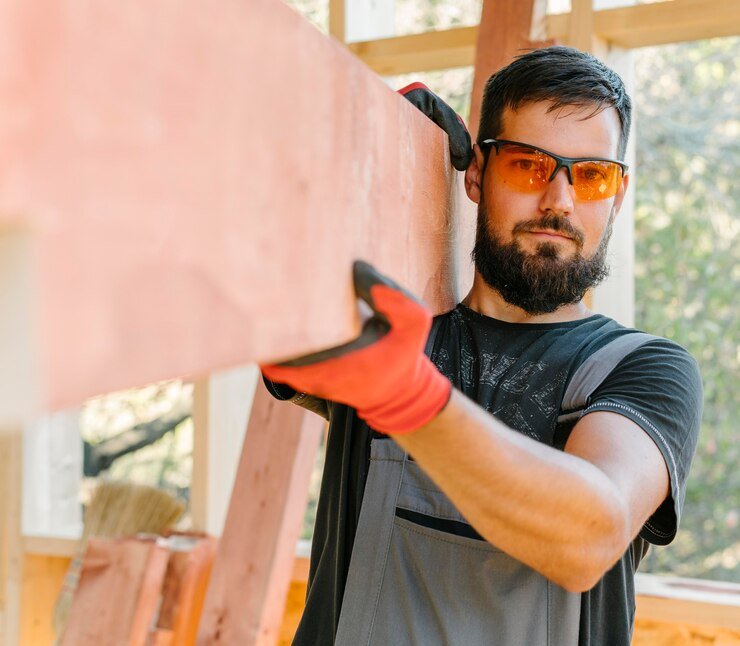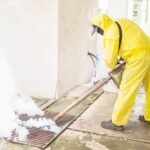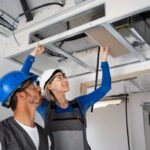Glass Reinforced Plastic (GRP), also known as fibreglass, is gaining popularity in the domestic building sector due to its versatility, durability, and energy efficiency. This lightweight yet strong material is being increasingly manufactured and used for various applications in residential construction, including roofing, cladding, window frames, and water storage tanks, offering homeowners long-lasting and low-maintenance solutions.
GRP Cladding for Homes
GRP cladding has emerged as a popular choice for residential exteriors, offering homeowners a durable, low-maintenance, and aesthetically pleasing alternative to traditional materials. This innovative solution combines the strength of glass fibers with the versatility of polymers, resulting in a lightweight yet robust cladding system that can transform the appearance and performance of homes.
One of the primary advantages of GRP cladding for residential use is its exceptional durability. Unlike wood or metal cladding, GRP is highly resistant to corrosion, weathering, and UV radiation, ensuring that it maintains its structural integrity and visual appeal for years with minimal upkeep. This resilience makes it particularly suitable for homes in coastal areas or regions with harsh climates, where traditional materials might deteriorate rapidly.
The design flexibility of GRP cladding allows homeowners to achieve a wide range of architectural styles. It can be molded into various shapes, textures, and patterns, enabling the creation of intricate facades that would be impractical or costly with other materials. This versatility extends to color options as well, with GRP cladding available in an extensive palette to complement any home’s design scheme.
Installation of GRP cladding is typically faster and more straightforward than traditional materials, reducing labor costs and minimizing disruption to homeowners. The lightweight nature of GRP panels means they can be easily handled and fitted without the need for heavy machinery or specialized equipment. This characteristic also makes GRP an excellent choice for over-cladding existing structures, providing a cost-effective way to refresh and insulate older homes without the need for extensive structural modifications.
Energy efficiency is another significant benefit of GRP cladding for residential applications. The material’s inherent insulating properties help regulate indoor temperatures, potentially leading to reduced heating and cooling costs. When combined with appropriate insulation systems, GRP cladding can contribute to creating a more comfortable living environment while improving the overall energy performance of the home.
Maintenance requirements for GRP cladding are minimal, offering homeowners a practical solution that saves time and money in the long run. Unlike wood, which may require regular painting or treatment, or metal, which can be prone to rust, GRP cladding typically only needs occasional cleaning to maintain its appearance. This low-maintenance characteristic is particularly appealing for busy homeowners or those looking to reduce ongoing property upkeep costs.
While the initial investment in GRP cladding may be higher than some traditional materials, its long-term cost-effectiveness is compelling. The combination of durability, energy efficiency, and low maintenance requirements often results in lower lifecycle costs compared to alternatives that may require frequent replacement or repair.
As sustainability becomes an increasingly important consideration in home construction and renovation, GRP cladding offers several environmental benefits. Its longevity reduces the need for frequent replacements, and the lightweight nature of the material can contribute to reduced transportation emissions during installation. Additionally, some manufacturers are now producing GRP cladding using eco-friendly materials and processes, further enhancing its appeal to environmentally conscious homeowners.
In conclusion, GRP cladding represents a modern, efficient, and versatile solution for residential exteriors. Its combination of durability, design flexibility, energy efficiency, and low maintenance requirements makes it an attractive option for homeowners looking to enhance both the appearance and performance of their properties.
Thermal Insulation with GRP
Glass Reinforced Plastic (GRP) has emerged as an excellent thermal insulation material for residential construction, offering significant benefits in energy efficiency and comfort. The inherent properties of GRP make it an ideal choice for improving the thermal performance of homes, contributing to reduced energy consumption and lower utility costs.
GRP’s thermal insulation capabilities stem from its unique composition. The combination of glass fibers and polymer resin creates a material with low thermal conductivity, effectively minimizing heat transfer between the interior and exterior of a building. This property allows GRP to maintain comfortable indoor temperatures by reducing heat loss in winter and heat gain in summer, leading to more consistent and energy-efficient climate control.
The versatility of GRP allows for its integration into various aspects of home construction, enhancing overall thermal performance. When used in roofing, cladding, or as part of a building’s envelope, GRP acts as an effective barrier against thermal bridging, a common issue in traditional construction methods. This comprehensive approach to insulation helps create a more uniform thermal envelope, reducing cold spots and improving overall energy efficiency.
One of the key advantages of GRP in thermal insulation is its ability to maintain its insulating properties over time. Unlike some traditional insulation materials that may settle or degrade, GRP retains its structural integrity and insulating effectiveness throughout its lifespan. This durability ensures long-term energy savings and consistent thermal performance, making it a cost-effective solution for homeowners.
The application of GRP in thermal insulation extends beyond just temperature regulation. Its sound insulation properties contribute to creating quieter indoor environments, enhancing overall comfort in residential spaces. This dual benefit of thermal and acoustic insulation makes GRP an attractive option for homeowners seeking comprehensive solutions for their living spaces.
In the context of eco-friendly construction, GRP’s role in thermal insulation aligns well with sustainable building practices. By reducing the energy required for heating and cooling, GRP-insulated homes contribute to lower carbon emissions over their lifetime. This long-term environmental benefit, coupled with the material’s durability, positions GRP as a sustainable choice for energy-conscious homeowners.
It’s worth noting that the effectiveness of GRP in thermal insulation can be further enhanced when combined with other energy-efficient technologies and design strategies. For instance, integrating GRP insulation with optimized building layouts and advanced HVAC systems can lead to even greater improvements in a home’s overall energy performance.
As the construction industry continues to prioritize energy efficiency and sustainable practices, the use of GRP for thermal insulation in residential buildings is likely to increase. Its combination of excellent insulating properties, durability, and versatility makes it a valuable component in creating energy-efficient, comfortable, and environmentally responsible homes.
GRP Roofing in Residences
GRP (Glass Reinforced Plastic) roofing has become increasingly popular in residential applications due to its exceptional durability, versatility, and low maintenance requirements. This innovative roofing solution offers homeowners a long-lasting alternative to traditional materials, particularly for flat or low-sloped roofs on extensions, porches, garages, and balconies.
One of the primary advantages of GRP roofing is its impressive lifespan. When properly installed, a GRP roof can last up to 50 years, significantly outlasting traditional felt roofing which typically lasts between 10-30 years. This longevity is attributed to the material’s inherent strength and resistance to various environmental factors.
GRP roofing provides excellent waterproofing properties, creating a seamless and watertight finish that effectively eliminates the risk of water damage. The material is highly resistant to rain, snow, UV rays, and extreme temperatures, ensuring year-round protection for residential structures. This resistance to weather elements translates to minimal maintenance requirements, allowing homeowners to “fit and forget” their roof for decades.
The installation process for GRP roofing is relatively quick and straightforward, typically taking only two days to complete. This efficiency minimizes disruption to homeowners and reduces labor costs. GRP can be cold-applied, eliminating the need for open flames during installation and significantly reducing the risk of fire-related accidents.
Aesthetically, GRP roofing offers homeowners a range of customization options. The material can be finished in various colors, including traditional dark grey and modern shades, allowing it to complement different architectural styles. The top coat resin finish provides a more visually appealing look compared to the rubbery appearance of some alternative roofing systems.
For environmentally conscious homeowners, GRP roofing presents a sustainable choice. The material is recyclable and its long lifespan reduces the need for frequent replacements, contributing to a lower carbon footprint over time. Additionally, the lightweight nature of GRP makes it an excellent option for green roofs, further enhancing its eco-friendly credentials.
In terms of cost-effectiveness, while the initial investment in GRP roofing may be higher than some alternatives, its durability and low maintenance requirements often result in lower lifecycle costs. The material’s resistance to UV light and general weathering means it rarely needs repairs, and when maintenance is required, it’s typically simple and cost-effective.
For homeowners considering upgrading an aging roof, GRP fibreglass offers an excellent solution. In some cases, it can be installed directly over existing roofs, reducing disruption and costs associated with complete roof removal. This makes it an attractive option for those looking to improve their home’s weatherproofing without extensive renovations.
In conclusion, GRP roofing provides residential properties with a robust, long-lasting, and aesthetically pleasing roofing solution. Its combination of durability, low maintenance, and customization options makes it an increasingly popular choice for homeowners seeking reliable and efficient roofing systems.
Energy Efficiency with GRP
Glass Reinforced Plastic (GRP) plays a significant role in enhancing energy efficiency in residential buildings, offering a range of benefits that contribute to reduced energy consumption and lower utility costs. The material’s unique properties make it an excellent choice for improving a home’s overall energy performance.
One of the primary ways GRP contributes to energy efficiency is through its superior insulation properties. GRP has low thermal conductivity, which means it effectively minimizes heat transfer between the interior and exterior of a building. This characteristic helps maintain stable indoor temperatures, reducing the need for excessive heating in winter and cooling in summer. As a result, homes with GRP components can experience lower energy demands for climate control, leading to reduced greenhouse gas emissions and a smaller carbon footprint.
The lightweight nature of GRP also contributes to energy savings in transportation and installation. Compared to traditional materials like steel or concrete, GRP requires less energy for transportation and often eliminates the need for heavy machinery during installation. This reduction in energy use during the construction phase contributes to the overall energy efficiency of the building process.
GRP’s durability and resistance to environmental factors play a crucial role in maintaining long-term energy efficiency. Unlike some materials that degrade over time, GRP retains its insulating properties and structural integrity for many years, ensuring consistent energy performance throughout its lifespan. This longevity reduces the need for frequent replacements or repairs, further conserving resources and energy.
In the context of water storage and distribution, GRP tanks offer significant energy-saving benefits. Their excellent insulation properties help maintain water temperature, reducing the energy required for heating or cooling stored water. This is particularly beneficial in hot climates, where keeping water cool can be energy-intensive.
GRP’s versatility allows for innovative design solutions that can enhance a home’s energy efficiency. For instance, GRP can be used to create complex shapes and structures that optimize natural lighting and ventilation, reducing reliance on artificial lighting and mechanical ventilation systems. This design flexibility enables architects and builders to create energy-efficient homes that maximize the use of passive solar energy and natural airflow.
Moreover, GRP’s role in renewable energy applications further underscores its contribution to energy efficiency. The material is widely used in the production of wind turbine blades and components for solar energy systems, supporting the transition to cleaner energy sources. For homeowners looking to incorporate renewable energy solutions, GRP components can be an integral part of these systems, enhancing overall energy efficiency.
When used in roofing applications, GRP can contribute to the creation of cool roofs. Its ability to reflect solar radiation helps reduce heat absorption, lowering cooling costs in warm climates. This reflective property can be enhanced with the application of special coatings, further improving the energy performance of the roof.
It’s important to note that while GRP offers significant energy efficiency benefits, its effectiveness is maximized when integrated into a comprehensive energy management strategy. Combining GRP components with other energy-efficient technologies, such as smart home systems and high-performance HVAC equipment, can lead to even greater energy savings and improved home comfort.
In conclusion, GRP’s contribution to energy efficiency in residential buildings is multifaceted, encompassing insulation, durability, design flexibility, and support for renewable energy systems. As energy efficiency continues to be a priority in home construction and renovation, GRP stands out as a versatile and effective material for creating more sustainable and energy-efficient living spaces.
GRP Maintenance and Longevity
Glass Reinforced Plastic (GRP) components in residential construction offer exceptional longevity and require minimal maintenance, making them an attractive option for homeowners seeking durable and cost-effective building solutions. The average lifespan of GRP products in construction applications typically ranges from 25 to 30 years, with proper care potentially extending this to 40 years or more.
One of the key factors contributing to GRP’s longevity is its inherent resistance to environmental stressors. Unlike traditional materials such as steel or concrete, GRP does not corrode, rust, or degrade significantly over time. This resistance to weathering and chemical exposure ensures that GRP components maintain their structural integrity and appearance for decades, even in harsh climates or polluted urban environments.
To maximize the lifespan of GRP components, regular maintenance is recommended, albeit minimal compared to other materials. Biannual or annual inspections, depending on environmental conditions, are typically sufficient to identify and address any potential issues early on. These inspections should focus on checking for any signs of surface wear, ensuring that seals and joints remain intact, and verifying that the GRP components are still properly secured.
Maintenance tasks for GRP are generally straightforward and cost-effective. Regular cleaning to remove dirt, debris, and potential contaminants is usually all that’s required to keep GRP surfaces in good condition. Unlike steel or wood, GRP does not need painting or coating to maintain its protective properties, significantly reducing long-term maintenance costs.
In roofing applications, GRP has demonstrated impressive durability. When properly installed, GRP roofs can last up to 50 years, significantly outlasting traditional felt roofing which typically lasts between 10-30 years. This extended lifespan not only provides long-term cost savings but also reduces the environmental impact associated with frequent roof replacements.
For GRP water tanks, which are common in residential settings, the material’s durability translates to a service life of at least 25 years, with proper maintenance potentially extending this to 30 or 40 years. This longevity is particularly beneficial in water storage applications, where the cost and disruption of frequent tank replacements can be significant.
It’s worth noting that the longevity of GRP components is also influenced by the quality of materials used and the expertise of installation. High-quality resins and glass fibers, combined with proper installation techniques, can significantly enhance the durability and lifespan of GRP products. Therefore, homeowners should prioritize working with reputable manufacturers and experienced installers to ensure the best long-term performance of their GRP components.
In conclusion, the combination of durability, low maintenance requirements, and long lifespan makes GRP an excellent choice for various residential applications. Its ability to withstand environmental stressors while maintaining its structural and aesthetic properties over decades offers homeowners a reliable and cost-effective solution for their building needs.
Summary
Glass Reinforced Plastic (GRP) has proven to be a versatile and invaluable material in residential construction, offering multiple benefits across various applications. From its exceptional performance in cladding and roofing to its superior thermal insulation properties, GRP provides homeowners with durable, energy-efficient, and low-maintenance solutions. The material’s long lifespan, typically ranging from 25 to 50 years depending on the application, coupled with its resistance to environmental factors, makes it a cost-effective choice for long-term investment in home construction and renovation. As sustainability and energy efficiency continue to drive construction trends, GRP’s role in creating more environmentally responsible and comfortable living spaces becomes increasingly significant.







